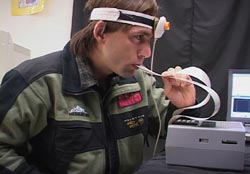Dr. Paul Bach-y-Rita, from the University of Wisconsin, has developed the BrainPort, a technology that allows one set of sensory information to substitute for another in the brain.
Using electronic aids, vision can be represented on the skin, tongue or through the ears. If the sense of touch is gone from one part of the body, it can be routed to an area where touch sensations are intact.
More than 30 years ago, Bach-y-Rita developed a device that routed visual images to electrodes taped to people’s backs, allowing them to “see” large objects and flickering candles with their backs. He then found out that the tongue, sensitive and easy to reach, turned out to be an even better place to deliver substitute senses.
Sensory substitution technology may one day help millions of people overcome their sensory disabilities.

Erik Weihenmayer, blind since he was 13, recently tried the BrainPort, a hard hat carrying a small video camera. Visual information from the camera was translated into pulses that reached his tongue. He found doorways, caught balls rolling toward him, etc. for the first time in more than 20 years.
The government has shown interest in sensory substitution technology. For example, the Navy is exploring the use of a tongue device to help divers find their way in dark waters at night.
But the tongue unit have also been tried out in a video game that involved shooting villains. “In two minutes you stop feeling the buzz on your tongue and get a visual representation of the bad guy,” explains the researcher. “You feel like you have X-ray vision. Unfortunately it makes the game boring.”
Via The New York Times.
